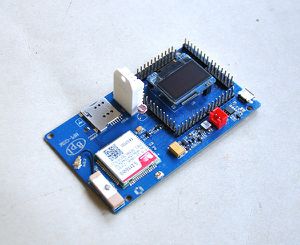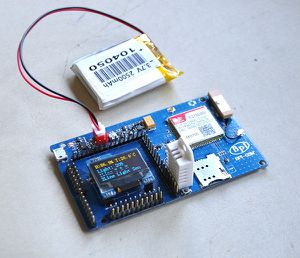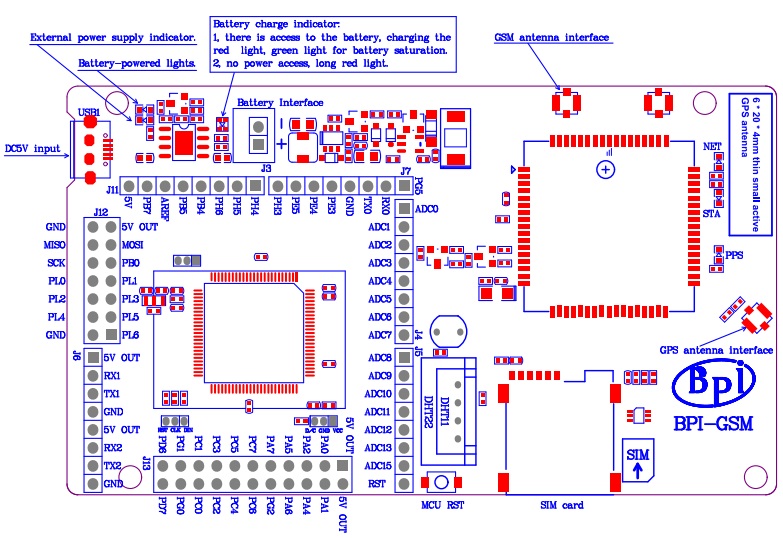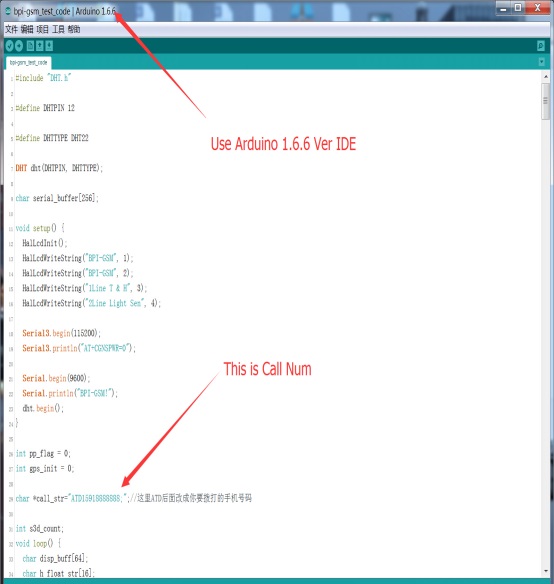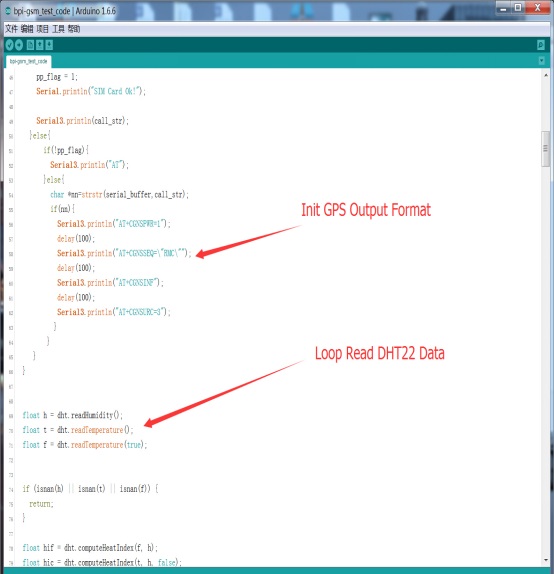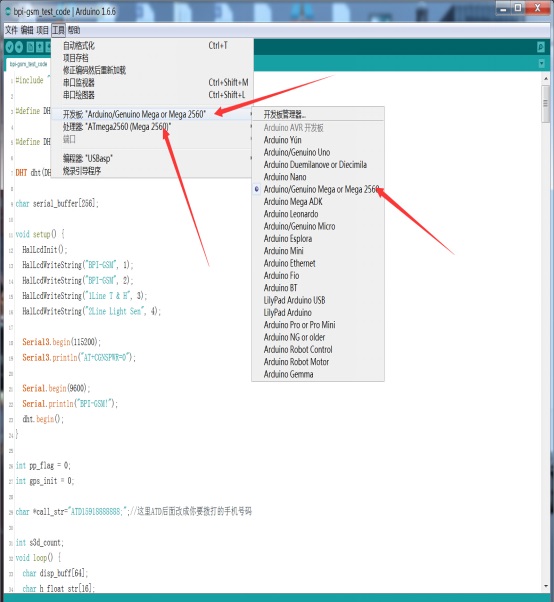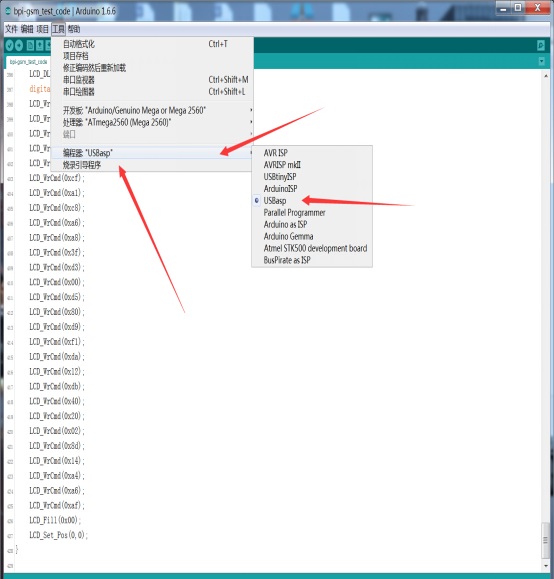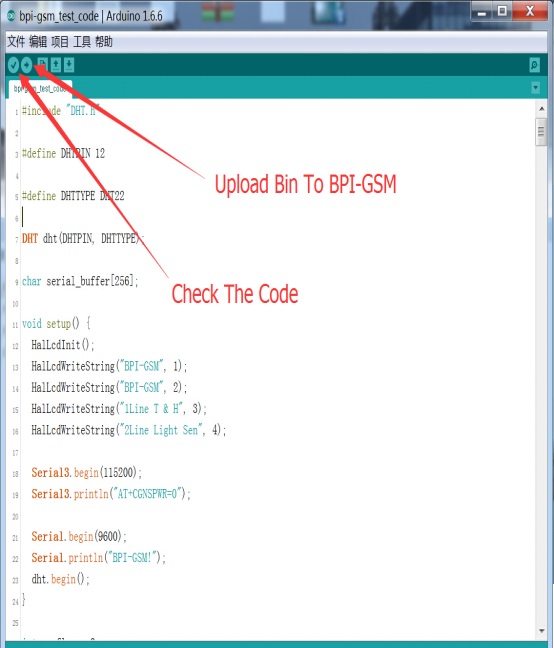BPI-GSM module
Contents
Introduction
BPI-GSM is a development board based on ATmega2560 MCU,using 16 MHz crystal oscillator. It features 54 digital I/O (14 of which can be used as PWM),16 analog input, 4 UART (hardware serial ports). Connected with SIM808 GSM module through serial port, it can make phone call,text,GPS positioning.Equipped with high precision DHT22 temperature and humidity sensor,data can be displayed on BPI LED.The board is powered by 2500MA lithium battery and can be charged with USB. A simple application of BPI-GSM is mobile environment monitors.
The peripheral modules of Arduino are growing fast due to the open source as well as the developing environment which uses C language borrowed java cross platform concept. And the main reason that attracts Artist to use Arduino is the easy and fast communication with other software such as Flash and Processing using Arduino language to create interactive multimedia works. The IDE of Arduino is open source, which enables you free download to create your own works such as special topic,school teaching,motor control...
BPI-GSM has two power options, USB or external, and it can switch automatically.For external power option,you can choose AC-to-DC adapter(5V,2A) or battery, and the voltage range should be 4.5V - 5.5V, it might be unstable if voltage drops under 4.5V due to the 5V level can not be guaranteed on I/O pins. If the voltage exceeds 5.5V, power regulator may trigger thermal protection, more harm would be to BPI-GSM if over-voltage continues. So the recommended operational power is 4.5V-5.5V, 2A rating.
Key Features
- photocell: measuring the current light luminance;
- high precision temperature&humidity sensor: measure current temperature and relative humidity
- GSM module: can be used to make phone call, text,2G connectivity,GPS positioning.
- Developed on Arduino, with the main chip:2560,communicate with Arduino using AT command
- support powered by battery.
Hardware
| HardwareSpecification of BPi GSM moudle | |||
| Microcontroller | ATmega2560 | ||
| Operating Voltage | 5V | ||
| Digital I/O Pins | 54 (of which 15 provide PWM output) | ||
| Analog Input Pins | 16 | ||
| DC Current per I/O Pin | 40 mA | ||
| DC Current for 3.3V Pin | 50 mA | ||
| Flash Memory | 256 KB of which 8 KB used by bootloader | ||
| SRAM | 8 KB | ||
| EEPROM | 4 KB | ||
| Clock Speed | 16MHz | ||
BPI-GSM sketch map
Software
How to use BPI-GSM module
test code download:https://drive.google.com/file/d/0B4PAo2nW2KfnOWxXeTdkWlY0c2c/view?usp=sharing
Please use arduino 1.6.6 Ver IDE,if you know arduino,it is easy to use.
SIM808 module
S IM808 module is a complete Quad-Band GSM/GPRS module which combines GPS technology for satellite
navigation. The compact design which integrated GPRS and GPS in a SMT package will significantly save both time and costs for customers to develop GPS enabled applications. Featuring an industry-standard interface and GPS function, it allows variable assets to be tracked seamlessly at any location and anytime with signal coverage.
General features:
- Quad-band 850/900/1800/1900MHz
- GPRS multi-slot class 12/10
- GPRS mobile station class B
- Compliant to GSM phase 2/2+
– Class 4 (2 W @ 850/900MHz) – Class 1 (1 W @ 1800/1900MHz)
- Bluetooth: compliant with 3.0+EDR
- Dimensions: 24*24*3mm
- Weight: TBD
- Control via AT commands (3GPP TS 27.007,27.005 and SIMCOM enhanced AT Commands)
- Supply voltage range 3.4 ~ 4.4V
- Low power consumption
- Operation temperature:-40℃ ~85℃
Specifications for GPRS Data:
- GPRS class 12: max. 85.6 kbps (downlink/uplink)
- PBCCH support
- Coding schemes CS 1, 2, 3, 4
- PPP-stack
- CSD up to 14.4 kbps
- USSD
- Non transparent mode
Specifications for SMS via GSM/GPRS:
- Point to point MO and MT
- SMS cell broadcast
- Text and PDU mode
Software features:
- 0710 MUX protocol
- Embedded TCP/UDP protocol
- FTP/HTTP
- MMS
- DTMF
- Jamming Detection
- Audio Record
- TTS (optional)
- Embedded AT (optional)
Compatibility:
- AT cellular command interface
Interfaces:
- 68 SMT pads including
- Analog audio interface
- PCM interface(optional)
- SPI interface (optional)
- RTC backup
- Serial interface
- USB interface
- Interface to external SIM 3V/1.8V
- Keypad interface
- GPIO
- ADC
- GSM Antenna pad
- Bluetooth Antenna pad
- GPS Antenna pad
Specification for GPS:
- Receiver type:-22 tracking /66 acquisition -channel,-GPS L1 C/A code
- Sensitivity:-Tracking: -165 dBm,-Cold starts : -148 dBm
- Time-To-First-Fix:-Cold starts: 30s (typ.),-Hot starts: 1s (typ.)
- Accuracy:-Horizontal position : <2.5m CEP
- Power consumption (GSM engine in idle mode):-Acquisition 24mW,-Tracking 17mW
Resources
BPI-GSM module schematic diagram : https://drive.google.com/file/d/0B4PAo2nW2Kfnekg2S0JLaHVxbkU/view?usp=sharing
Video demo on youtube: https://www.youtube.com/watch?v=ezc8UDYJUBM&feature=youtu.be
Forum : http://forum.banana-pi.org/c/BPI-Iot-module/GSM-module
quick to buy sample : http://www.aliexpress.com/store/product/Newest-items-BPI-GSM-Module-for-making-phone-call-text-2G-connectivity-GPS-positioning/302756_1000001448261.html
